Analysis of the Spatio-Temporal Patterns of Shrinking Cities in China: Evidence from Nighttime Light
Abstract
:1. Introduction
2. Materials
2.1. Study Area
2.2. Nighttime Light Data
3. Methods
3.1. Identifying Shrinking Cities
3.2. Measuring Urban Shrinkage Intensity
3.3. Spatio-Temporal Evolution Process of Shrinking Cities
3.3.1. Standard Deviational Ellipse (SDE)
3.3.2. Spatial Autocorrelation
4. Results
4.1. Spatial Distribution and Urban Shrinkage Intensity of Shrinking Cities
4.2. Spatial-temporal Evolution of Shrinking Cities
4.3. Analysis of Spatial pattern of Shrinking Cities/Growing Cities
5. Discussion
5.1. Validation of Identified Results
5.2. Chinese Shrinking Cities Pattern Compared to That of Growing Cities
5.3. Contributions and Limitations
5.4. Policy Implications
5.4.1. Inspirations from EU Shrinking Cities Related Projects
5.4.2. For the NEC and NWC Economic Regions
5.4.3. Playing the Leading Role of Growth Poles in Shrinking Regions
6. Conclusions
- About 34.9% of cities in China have experienced or are experiencing shrinking, which is widely distributed throughout the entire country. The urban shrinkage phenomenon is most severe in northeast and northwest China.
- Temporally, the number of shrinking cities fluctuates, and 2015 and 2020 are the peak shrinkage years. Spatially, the shrinking cities show a northeast-to-southwest distribution, and spatial dispersion is clear. The shrinking center of gravity moved northwest from Zhumadian, Henan Province to Yan’an, Shaanxi Province, and then moved southeast to Shiyan, Hubei Province.
- The shrinkage and growth of cities appear to have spatial autocorrelation. The northeast region is the shrinkage hotspot during the first two stages, and the southwest part of SWC is the growth aggregation area. Throughout the entire study period, the aggregation degree of shrinkage continuously decreased (L-L) and the aggregation trend of growth continuously increased (H-H), indicating that the radiative driving effect of the growth pole is further enhanced. The severe shrinkage in the northeast area was slightly alleviated in the late stage. The impact of COVID-19 on areas with export-oriented economies, such as the southeast coast, cannot be ignored.
Author Contributions
Funding
Institutional Review Board Statement
Informed Consent Statement
Data Availability Statement
Conflicts of Interest
References
- Häußermann, H.; Siebel, W. Die schrumpfende Stadt und die Stadtsoziologie. Soziologische Stadtforsch. 1988, 29, 78–94. [Google Scholar] [CrossRef]
- Alves, D.; Barreira, A.P.; Guimarães, M.H.; Panagopoulos, T. Historical trajectories of currently shrinking Portuguese cities: A typology of urban shrinkage. Cities 2016, 52, 20–29. [Google Scholar] [CrossRef] [Green Version]
- Oswalt, P.; Rieniets, T. Atlas of Shrinking Cities; Hatje Cantz: Ostfildern-Ruit, Germany, 2006. [Google Scholar]
- Haase, A.; Rink, D.; Grossmann, K.; Bernt, M.; Mykhnenko, V. Conceptualizing urban shrinkage. Environ. Plan. A 2014, 46, 1519–1534. [Google Scholar] [CrossRef] [Green Version]
- Dong, B.; Ye, Y.; You, S.; Zheng, Q.; Huang, L.; Zhu, C.; Tong, C.; Li, S.; Li, Y.; Wang, K. Identifying and classifying shrinking cities using long-term continuous night-time light time series. Remote Sens. 2021, 13, 31–42. [Google Scholar]
- Turok, I.; Mykhnenko, V. The trajectories of European cities, 1960–2005. Cities 2007, 24, 165–182. [Google Scholar] [CrossRef]
- Mykhnenko, V.; Turok, I. East European cities–patterns of growth and decline, 1960–2005. Int. Plan. Stud. 2008, 13, 311–342. [Google Scholar] [CrossRef]
- Schwarz, K.; Berland, A.; Herrmann, D.L. Green, but not just? Rethinking environmental justice indicators in shrinking cities. Sustain. Cities Soc. 2018, 41, 816–821. [Google Scholar] [CrossRef]
- Beauregard, R.A. Urban population loss in historical perspective: United States, 1820–2000. Environ. Plan. A 2009, 41, 514–528. [Google Scholar] [CrossRef]
- Jeon, Y.; Kim, S. Housing abandonment in shrinking cities of East Asia: Case study in Incheon, South Korea. Urban Studies 2020, 57, 1749–1767. [Google Scholar] [CrossRef]
- Audirac, I. Introduction: Shrinking cities from marginal to mainstream: Views from North America and Europe. Cities 2018, 75, 1–5. [Google Scholar] [CrossRef]
- Mallach, A. What we talk about when we talk about shrinking cities: The ambiguity of discourse and policy response in the United States. Cities 2017, 69, 109–115. [Google Scholar] [CrossRef]
- Deng, T.; Wang, D.; Yang, Y.; Yang, H. Shrinking cities in growing China: Did high speed rail further aggravate urban shrinkage? Cities 2019, 86, 210–219. [Google Scholar] [CrossRef]
- National Bureau of Statistics of China. China Statistical Yearbook; China Statistics Press: Beijing, China, 2020.
- Xu, B.; Pang, D. Growth and decline: A study on international urban contraction and its implications for China. Economist 2014, 4, 5–13. [Google Scholar]
- Jin, X.; Long, Y.; Sun, W.; Lu, Y.; Yang, X.; Tang, J. Evaluating cities’ vitality and identifying ghost cities in China with emerging geographical data. Cities 2017, 63, 98–109. [Google Scholar] [CrossRef]
- Wu, K. Cognitive misunderstanding and spatial planning response of urban contraction. Beijing Plan. Rev. 2019, 3, 4–11. [Google Scholar]
- Guan, D.; He, X.; Hu, X. Quantitative identification and evolution trend simulation of shrinking cities at the county scale, China. Sustain. Cities Soc. 2021, 65, 102611. [Google Scholar] [CrossRef]
- Guo, Y.; Li, L. Change in the negative externality of the shrinking cities in China. Sci. Geogr. Sin. 2019, 39, 52–60. [Google Scholar]
- Wen, J.; Song, Y.; Ren, G. Assessment of urban contraction in Chin: Based on data from municipal districts at prefecture level and above. Urban Probl. 2019, 9, 4–10. [Google Scholar]
- Murdoch, J., III. Specialized vs. diversified: The role of neighborhood economies in shrinking cities. Cities 2018, 75, 30–37. [Google Scholar] [CrossRef]
- Zhang, Y.; Fu, Y.; Kong, X.; Zhang, F. Prefecture-level city shrinkage on the regional dimension in China: Spatiotemporal change and internal relations. Sustain. Cities Soc. 2019, 47, 101490. [Google Scholar] [CrossRef]
- Zhou, Y.; Li, C.; Zheng, W.; Rong, Y.; Liu, W. Identification of urban shrinkage using NPP-VIIRS nighttime light data at the county level in China. Cities 2021, 118, 103373. [Google Scholar] [CrossRef]
- Bernt, M. The limits of shrinkage: Conceptual pitfalls and alternatives in the discussion of urban population loss. Int. J. Urban Reg. 2016, 40, 441–450. [Google Scholar] [CrossRef]
- Hartt, M. The prevalence of prosperous shrinking cities. Ann. Assoc. Am. Geogr. 2019, 109, 1651–1670. [Google Scholar] [CrossRef]
- Wu, K.; Wang, X. Understanding growth and shrinkage phenomena of industrial and trade cities in southeastern China: Case study of Yiwu. J. Urban Plan. Dev. 2020, 146, 05020028. [Google Scholar] [CrossRef]
- Long, Y.; Wu, K.; Wang, J. Shrinking cities in China. Modern Urban Res. 2015, 9, 14–19. [Google Scholar]
- Zhang, X.; Liu, Y.; Lv, C. The background, identification of shrinking cities in China and characteristic analysis. Sci. Geogr. Sin. 2016, 18, 132–139. [Google Scholar]
- Long, Y. Redefining Chinese city system with emerging new data. Appl. Geogr. 2016, 75, 36–48. [Google Scholar] [CrossRef]
- Jiang, Z.; Zhai, W.; Meng, X.; Long, Y. Identifying shrinking cities with NPP-VIIRS nightlight data in China. J. Urban Plan Dev. 2020, 146, 04020034. [Google Scholar] [CrossRef]
- Niu, W.; Xia, H.; Wang, R.; Pan, L.; Meng, Q.; Qin, Y.; Li, R.; Zhao, X.; Bian, X.; Zhao, W. Research on large-scale urban shrinkage and expansion in the Yellow River affected area using night light data. ISPRS Int. J. Geo-Inf. 2021, 10, 5. [Google Scholar] [CrossRef]
- Chen, T.; Hui, E.C.; Tu, Y.; Lang, W. Growth or shrinkage: Discovering development patterns and planning strategies for cross-border areas in China. J. Urban Plan. Dev. 2021, 147, 05021046. [Google Scholar] [CrossRef]
- Elvidge, C.D.; Hsu, F.-C.; Baugh, K.E.; Ghosh, T. National trends in satellite-observed lighting. Glob. Urban Monit. Assess. Through Earth Obs. 2014, 23, 97–118. [Google Scholar]
- Gennaioli, N.; La Porta, R.; Lopez De Silanes, F.; Shleifer, A. Growth in regions. J. Econ. Growth 2014, 19, 259–309. [Google Scholar] [CrossRef]
- Li, F.; Yan, Q.; Bian, Z.; Liu, B.; Wu, Z. A POI and LST adjusted NTL urban index for urban built-up area extraction. Sensors 2020, 20, 2918. [Google Scholar] [CrossRef] [PubMed]
- Sun, L.; Tang, L.; Shao, G.; Qiu, Q.; Lan, T.; Shao, J. A machine learning-based classification system for urban built-up areas using multiple classifiers and data sources. Remote Sens. 2020, 12, 91. [Google Scholar] [CrossRef] [Green Version]
- Wu, R.; Yang, D.; Dong, J.; Zhang, L.; Xia, F. Regional inequality in China based on NPP-VIIRS night-time light imagery. Remote Sens. 2018, 10, 240. [Google Scholar] [CrossRef] [Green Version]
- Niu, F.; Xin, Z.; Sun, D. Urban land use effects of high-speed railway network in China: A spatial spillover perspective. Land Use Policy 2021, 105, 105417. [Google Scholar] [CrossRef]
- Yang, Y.; He, C.; Zhang, Q.; Han, L.; Du, S. Timely and accurate national-scale mapping of urban land in China using Defense Meteorological Satellite Program’s Operational Linescan System nighttime stable light data. J. Appl. Remote Sens. 2013, 7, 073535. [Google Scholar] [CrossRef]
- Li, X.; Zheng, X.; Yuan, T. Knowledge mapping of research results on DMSP/OLS nighttime light data. J. Geo-Inf. Sci. 2018, 20, 351–359. [Google Scholar]
- Elvidge, C.; Ziskin, D.; Baugh, K.; Tuttle, B.; Ghosh, T.; Pack, D.; Erwin, E.; Zhizhin, M. A fifteen-year record of global natural gas flaring derived from satellite data. Energies 2009, 2, 595–622. [Google Scholar] [CrossRef]
- Gibson, J.; Olivia, S.; Boe-Gibson, G.; Li, C. Which night lights data should we use in economics, and where? J. Dev. Econ. 2021, 149, 102602. [Google Scholar] [CrossRef]
- Wu, Y.; Shi, K.; Yv, B.; Li, C. Analysis of the impact of urban sprawl on haze pollution based on the NPP/VIIRS nighttime light remote sensing data. Geomat. Inf. Sci. Wuhan Univ. 2021, 46, 777–789. [Google Scholar]
- Yv, B.; Wang, C.; Gong, W.; Chen, Z.; Shi, K.; Wu, B.; Hong, Y. Nighttime light remote sensing and urban studies: Data, methods, applications and prospects. J. Remote Sens. 2021, 25, 342–364. [Google Scholar]
- Pan, W.; Fu, H.; Zheng, P. Regional poverty and inequality in the Xiamen-Zhangzhou-Quanzhou City Cluster in China based on NPP/VIIRS night-time light imagery. Sustainability 2020, 12, 2547. [Google Scholar] [CrossRef] [Green Version]
- Zhao, J.; Ji, G.; Yue, Y.; Lai, Z.; Chen, Y.; Yang, D.; Yang, X.; Wang, Z. Spatio-temporal dynamics of urban residential CO2 emissions and their driving forces in China using the integrated two nighttime light datasets. Appl. Energy 2019, 235, 612–624. [Google Scholar]
- Ma, T.; Zhou, C.; Pei, T.; Haynie, S.; Fan, J. Responses of Suomi-NPP VIIRS-derived nighttime lights to socioeconomic activity in China’s cities. Remote Sens. Lett. 2014, 5, 165–174. [Google Scholar] [CrossRef]
- Xie, Y.; Weng, Q.; Fu, P. Temporal variations of artificial nighttime lights and their implications for urbanization in the conterminous United States, 2013–2017. Remote Sens. Environ. 2019, 225, 160–174. [Google Scholar] [CrossRef]
- Yang, Y.; Wu, J.; Wang, Y.; Huang, Q.; He, C. Quantifying spatiotemporal patterns of shrinking cities in urbanizing China: A novel approach based on time-series nighttime light data. Cities 2021, 118, 03346. [Google Scholar] [CrossRef]
- Hollander, J. Polluted and Dangerous: America’s Worst Abandoned Properties and What Can Be Done about Them; University of Vermont Press: Burlington, VT, USA, 2009. [Google Scholar]
- Wiechmann, T. Errors expected-aligning urban strategy with demographic uncertainty in shrinking cities. Int. Plan. Stud. 2008, 13, 431–446. [Google Scholar] [CrossRef]
- Wu, K.; Li, Y. Research progress of urban land use and its ecosystem services in the context of urban shrinkage. J. Nat. Resour. 2019, 34, 1121–1134. [Google Scholar] [CrossRef]
- Wong, D.W. Several fundamentals in implementing spatial statistics in GIS: Using centrographic measures as examples. Geogr. Inf. Sci. 1999, 5, 163–174. [Google Scholar]
- Zhao, L.; Zhao, Z. Projecting the spatial variation of economic based on the specific ellipses in China. Sci. Geol. Sin. 2014, 34, 979–986. [Google Scholar]
- Hu, H. The distribution of population in China, with statistics and maps. Acta Geogr. Sin. 1935, 2, 33–74. [Google Scholar]
- General Office of the State Council. Opinions of The State Council on supporting Yunnan Province to Accelerate the Construction of Important Bridgeheads Opening to the Southwest. 3 November 2011. Available online: www.gov.cn/zwgk/2011-11/03/content_1985444.htm (accessed on 20 January 2022).
- Meng, X.; Long, Y. Shrinking cities in China: Evidence from the latest two population censuses 2010–2020. Environ. Plan. A Econ. Space 2022, 54, 449–453. [Google Scholar] [CrossRef]
- Rink, D.; Haase, A.; Bernt, M.; Großmann, K. Addressing Urban Shrinkage Across Europe–Challenges and Prospects; Shrink Smart Research Brief No. 1; Shrink Smart: Leipzig, Germany, 2010. [Google Scholar]
- Großmann, K.; Bontje, M.; Haase, A.; Mykhnenko, V. Shrinking cities: Notes for the further research agenda. Cities 2013, 35, 221–225. [Google Scholar] [CrossRef]
- Aurambout, J.P.; Schiavina, M.; Melchiori, M.; Fioretti, C.; Guzzo, F.; Vandecasteele, I.; Proietti, P.; Kavalov, B.; Panella, F.; Koukoufikis, G. Shrinking Cities; JRC126011; European Commission: Brussels, Belgium, 2021. [Google Scholar]
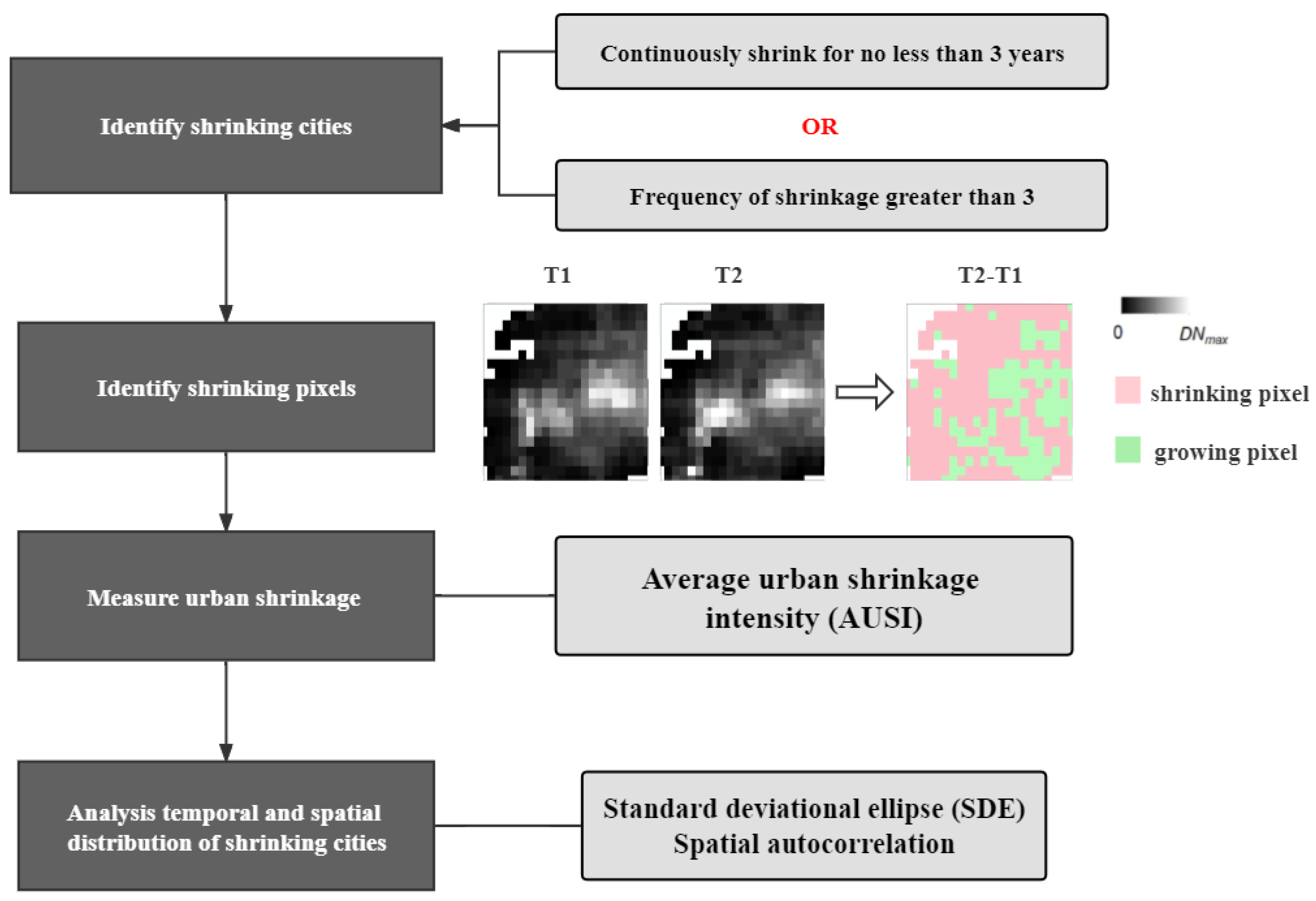

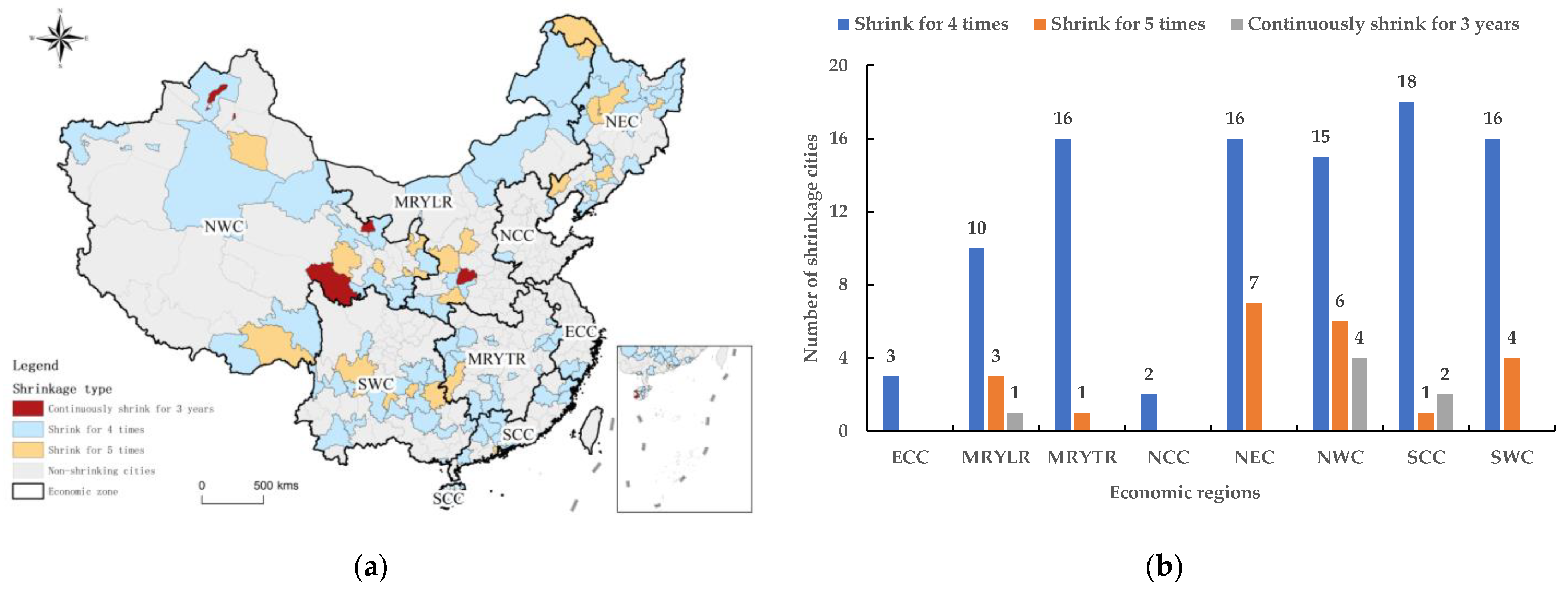
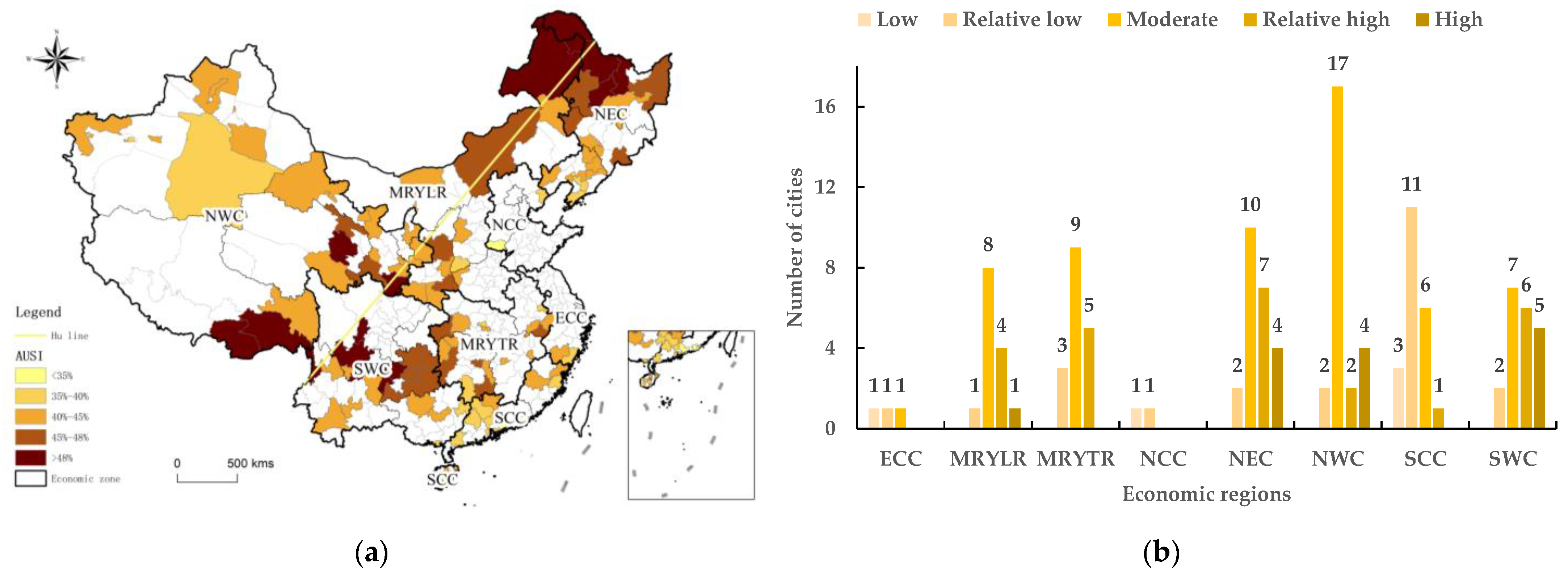
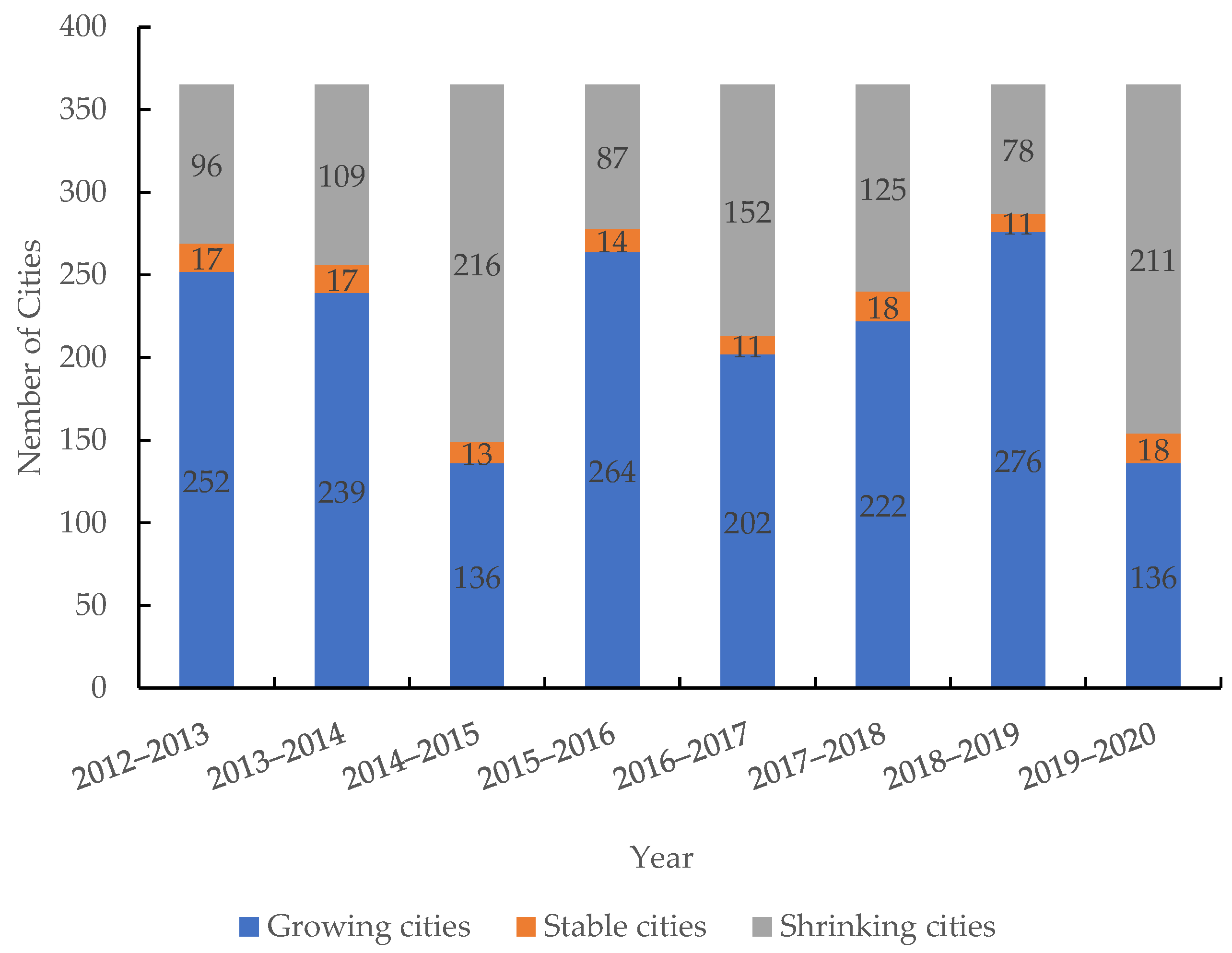
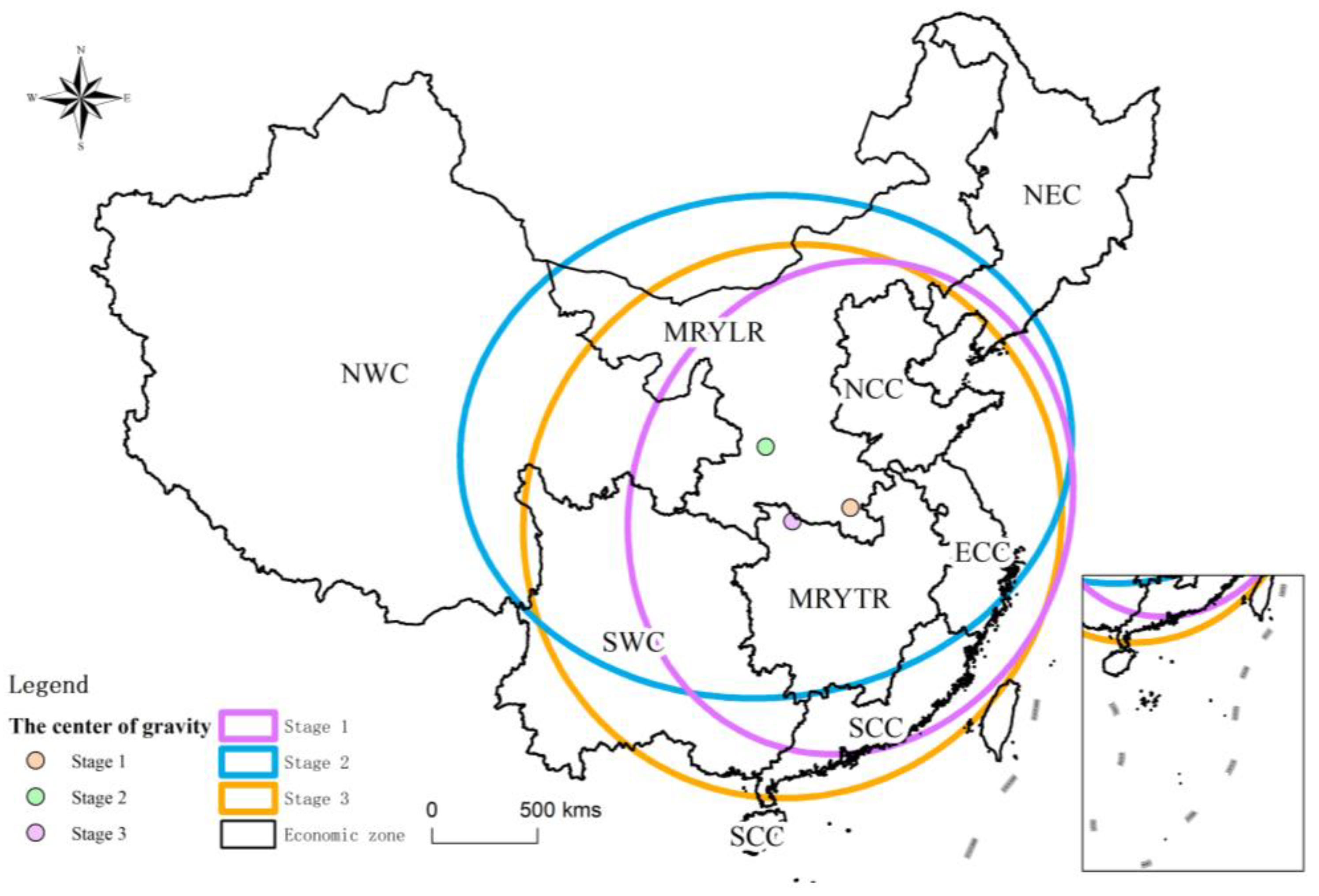
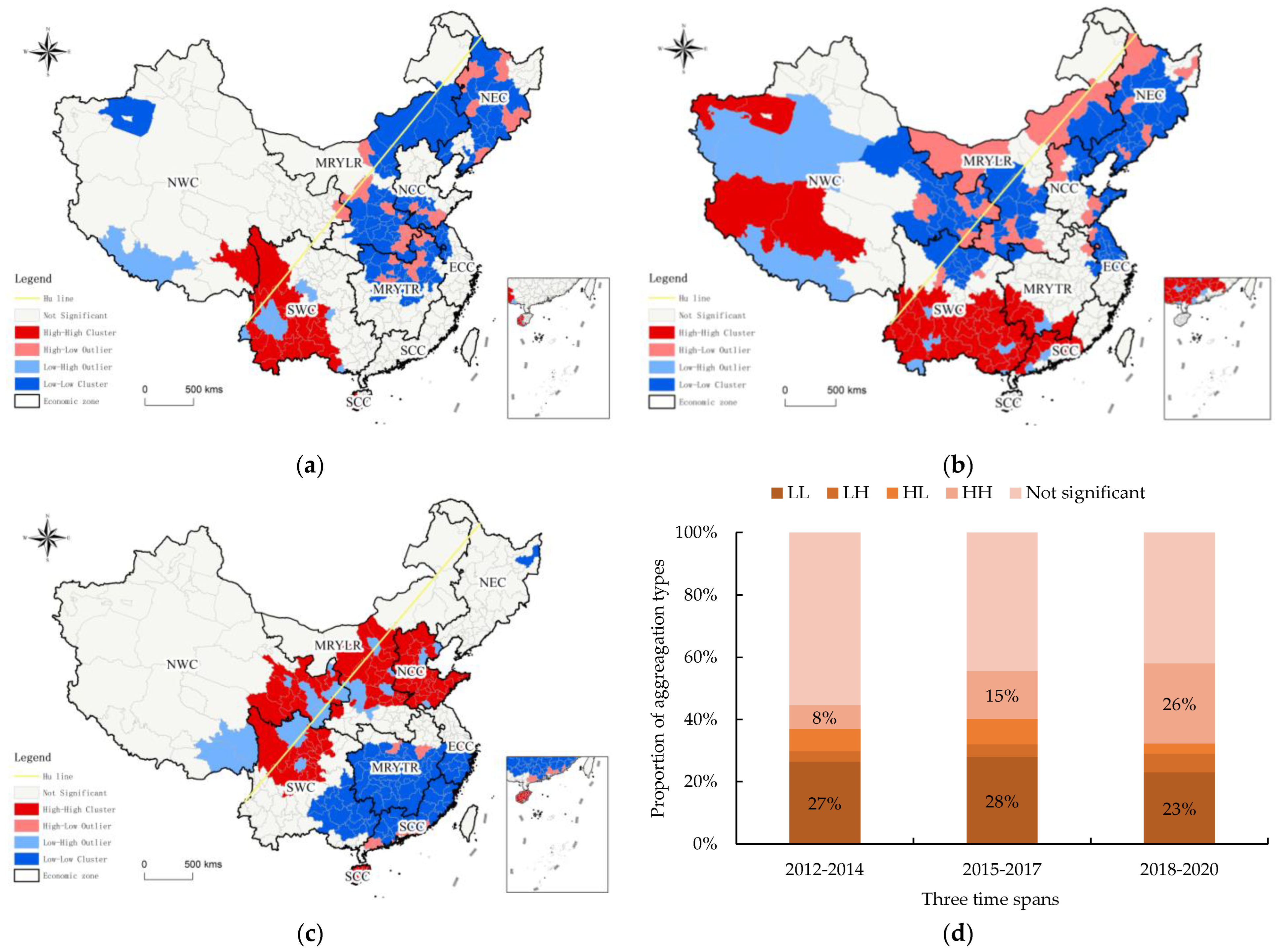

| Year | City | |
|---|---|---|
| 2012 | 337 | Beijing |
| 2013 | 293 | Shanghai |
| 2014 | 308 | Beijing |
| 2015 | 359 | Beijing |
| 2016 | 603 | Shanghai |
| 2017 | 398 | Shanghai |
| 2018 | 470 | Shanghai |
| 2019 | 528 | Shanghai |
| 2020 | 506 | Shenzhen |
| Authors | Definitions of Shrinking Cities |
|---|---|
| Oswalt and Rieniets [3] | Cities where the total population loss is more than 10% or the average annual population loss for three consecutive years is more than 1%. |
| Shrinking Cities International Research Network (SCIRN) [50,51] | Cities with a population of more than 10,000, experienced two years of population loss. |
| Wu and Li [52] | Ten years later, the urban population has decreased, and the population growth rate has been negative for more than three natural years. |
| Time Span | Area/km2 | Long Axis/km | Short Axis/km | Rotation Angle/Degree |
|---|---|---|---|---|
| 2012–2014 | 3,880,182 | 1041 | 1185 | 18 |
| 2015–2017 | 5,446,731 | 4090 | 3947 | 84 |
| 2018–2020 | 5,279,090 | 1269 | 1323 | 24 |
| 2012–2014 | 2015–2017 | 2018–2020 | |
|---|---|---|---|
| Moran’s I | 0.049 | 0.081 | 0.183 |
| z-score | 7.958 | 10.091 | 22.759 |
| p-value | 0 | 0 | 0 |
Publisher’s Note: MDPI stays neutral with regard to jurisdictional claims in published maps and institutional affiliations. |
© 2022 by the authors. Licensee MDPI, Basel, Switzerland. This article is an open access article distributed under the terms and conditions of the Creative Commons Attribution (CC BY) license (https://creativecommons.org/licenses/by/4.0/).
Share and Cite
Wang, Q.; Xin, Z.; Niu, F. Analysis of the Spatio-Temporal Patterns of Shrinking Cities in China: Evidence from Nighttime Light. Land 2022, 11, 871. https://doi.org/10.3390/land11060871
Wang Q, Xin Z, Niu F. Analysis of the Spatio-Temporal Patterns of Shrinking Cities in China: Evidence from Nighttime Light. Land. 2022; 11(6):871. https://doi.org/10.3390/land11060871
Chicago/Turabian StyleWang, Qi, Zhongling Xin, and Fangqu Niu. 2022. "Analysis of the Spatio-Temporal Patterns of Shrinking Cities in China: Evidence from Nighttime Light" Land 11, no. 6: 871. https://doi.org/10.3390/land11060871
APA StyleWang, Q., Xin, Z., & Niu, F. (2022). Analysis of the Spatio-Temporal Patterns of Shrinking Cities in China: Evidence from Nighttime Light. Land, 11(6), 871. https://doi.org/10.3390/land11060871






